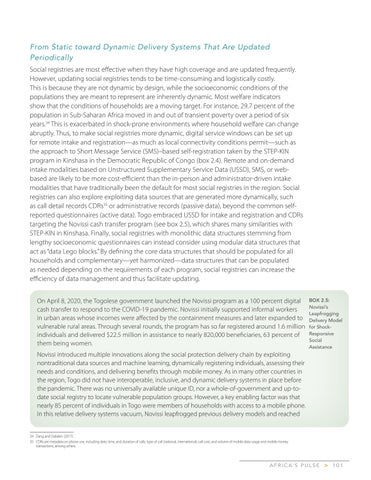From Static toward Dynamic Delivery Systems That Are Updated Periodically Social registries are most effective when they have high coverage and are updated frequently. However, updating social registries tends to be time-consuming and logistically costly. This is because they are not dynamic by design, while the socioeconomic conditions of the populations they are meant to represent are inherently dynamic. Most welfare indicators show that the conditions of households are a moving target. For instance, 29.7 percent of the population in Sub-Saharan Africa moved in and out of transient poverty over a period of six years.34 This is exacerbated in shock-prone environments where household welfare can change abruptly. Thus, to make social registries more dynamic, digital service windows can be set up for remote intake and registration—as much as local connectivity conditions permit—such as the approach to Short Message Service (SMS)–based self-registration taken by the STEP-KIN program in Kinshasa in the Democratic Republic of Congo (box 2.4). Remote and on-demand intake modalities based on Unstructured Supplementary Service Data (USSD), SMS, or webbased are likely to be more cost-efficient than the in-person and administrator-driven intake modalities that have traditionally been the default for most social registries in the region. Social registries can also explore exploiting data sources that are generated more dynamically, such as call detail records CDRs35 or administrative records (passive data), beyond the common selfreported questionnaires (active data). Togo embraced USSD for intake and registration and CDRs targeting the Novissi cash transfer program (see box 2.5), which shares many similarities with STEP-KIN in Kinshasa. Finally, social registries with monolithic data structures stemming from lengthy socioeconomic questionnaires can instead consider using modular data structures that act as “data Lego blocks.” By defining the core data structures that should be populated for all households and complementary—yet harmonized—data structures that can be populated as needed depending on the requirements of each program, social registries can increase the efficiency of data management and thus facilitate updating. On April 8, 2020, the Togolese government launched the Novissi program as a 100 percent digital cash transfer to respond to the COVID-19 pandemic. Novissi initially supported informal workers in urban areas whose incomes were affected by the containment measures and later expanded to vulnerable rural areas. Through several rounds, the program has so far registered around 1.6 million individuals and delivered $22.5 million in assistance to nearly 820,000 beneficiaries, 63 percent of them being women.
BOX 2.5: Novissi’s Leapfrogging Delivery Model for ShockResponsive Social Assistance
Novissi introduced multiple innovations along the social protection delivery chain by exploiting nontraditional data sources and machine learning, dynamically registering individuals, assessing their needs and conditions, and delivering benefits through mobile money. As in many other countries in the region, Togo did not have interoperable, inclusive, and dynamic delivery systems in place before the pandemic. There was no universally available unique ID, nor a whole-of-government and up-todate social registry to locate vulnerable population groups. However, a key enabling factor was that nearly 85 percent of individuals in Togo were members of households with access to a mobile phone. In this relative delivery systems vacuum, Novissi leapfrogged previous delivery models and reached 34 Dang and Dabalen (2017). 35 CDRs are metadata on phone use, including date, time, and duration of calls; type of call (national, international); call cost; and volume of mobile data usage and mobile money transactions, among others.
A F R I C A’ S P U L S E
>
101

